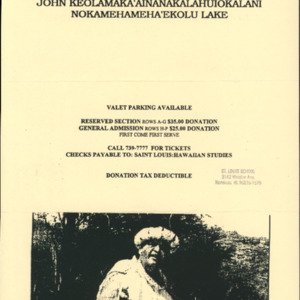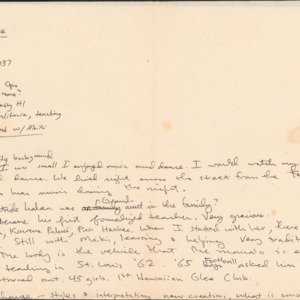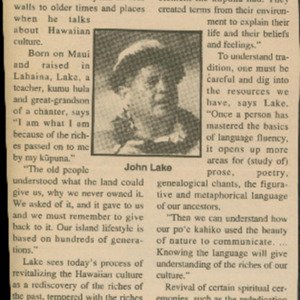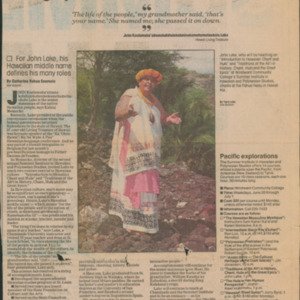John Keolamaka‘ainānakalāhuiokalani Lake
Title
John Keolamaka‘ainānakalāhuiokalani Lake
Description
John Keolamaka‘ainanakalāhuiokalani Lake
Born on Maui, John Lake moved to Oahu in 1954 to attend the University of Hawaiʻi at Mānoa and is currently a member of the faculty of St. Louis High School.
There is a tremendous clash today between the old values and modern values of Hawai‘i. With the creativity of the new styles and interpretations, the question today has become what is considered traditional hula? Today you have a lot of creative dances that exist for the sake of rhythm rather than the sake of language. Rhythm gives way to movement, movement gives way to theatrics, and theatrics give way to confusion.
My first kumu in the formal training sense was Aunty Mā‘iki Aiu Lake. I had studied informally at the age of six under my great-grandaunt but my real training in the kahiko began under Mā‘iki. She taught me that the beauty of the hula is to come to terms with the essence of one’s self. She said that the Hawaiians call your inner light the manaʻo and it is the real source of your dancing. Your body is simply an expression of your manaʻo. When I joined the hālau in 1964 there were only two other male dancers enrolled in the school. The emphasis and public attention was on ‘auwana but my interest was on the traditional hula and I found Mā‘iki to be both gracious and steeped in knowledge.
The central theme of the hālau was humility. Through humility everything is given to you. She defined the hula kahiko as the basic steps and styles passed down through the generations and we were expected to humble our own personalities to the dances. We were taught that hula expressed every sense: sight, hearing, feeling, tasting, and smelling.
My affiliation and work with Aunty Edith Kanaka‘ole through many years, brought me to understand the value of Hawaiian traditions, the respect of self and others, and the dignity of our Hawaiian values and heritage. She taught me much in chanting as to the projection of voice, control over the language and breathing, and essentially the necessity of having feeling in your chant in what one has to convey.
I began to teach in 1962 at St. Louis High School and in 1965 I was asked by some of my students to teach Hawaiian music. That turned into a Hawaiian glee club and eventually I began to train the students to dance in the hula style that I was taught. The greatest sacrifice I’ve made is family time. A hālau demands a tremendous amount of time. I try to balance this by making my family as much a part of the operation as possible. I give my time because to see a student really grasp the knowledge and tradition I am passing down is something special.
It’s alright for the young kumu to take the traditional styles to their full zenith but they can’t forget the basic questions of hula which are: who am I dancing for, and what am I dancing about? The changes that have come about are exciting but are we sacrificing the discipline and definitions of kahiko with these changes? Creative discipline by the kumu of each generation was the keystone to all of the masses of unwritten literature that has been passed down through the chants. There has been creativity in every generation but the original thought and theme of the chant remained the same and this discipline and order that was taken for granted in the past is breaking down today.
Citation
“John Keolamaka‘ainānakalāhuiokalani Lake,” Nā Kumu Hula Archive, accessed November 28, 2025, https://nakumuhula.org/archive/items/show/61.






